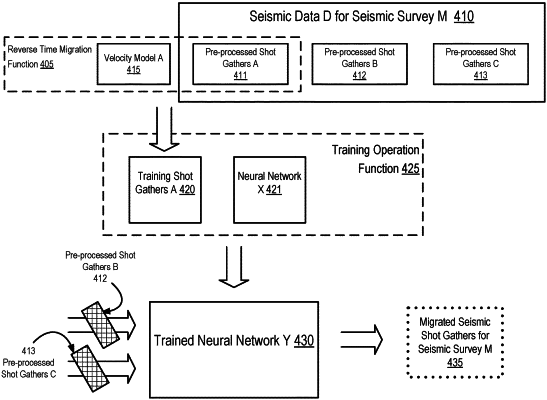| CPC G01V 1/345 (2013.01) [G01V 1/02 (2013.01); G01V 1/16 (2013.01); G01V 1/282 (2013.01); G06N 3/08 (2013.01); G01V 2210/121 (2013.01); G01V 2210/1295 (2013.01); G01V 2210/1425 (2013.01); G01V 2210/324 (2013.01); G01V 2210/74 (2013.01)] | 9 Claims |

|
1. A method, comprising:
acquiring, using a seismic surveying system, first seismic data regarding a first geological region of interest, wherein the seismic surveying system comprises a plurality of seismic receivers and a plurality of seismic sources,
wherein the plurality of seismic sources comprise a seismic vibrator configured to perform a vibroseis technique,
wherein at least one of the plurality of seismic receivers is a multi-component sensor that measures pressure waves in a plurality of spatial axes, and
wherein the plurality of seismic receivers comprises an accelerometer and a geophone;
determining, by a computer processor, a plurality of pre-processed gathers in a time domain using the first seismic data and seismic data processing operation, wherein the seismic data processing operation comprises a removal one or more surface waves from the first seismic data;
forward modeling, by the computer processor, a first seismic wavefield using a portion of the plurality of pre-processed gathers, a synthetic seismic source wavelet, and a first velocity model;
backward propagating, by the computer processor, a second seismic wavefield using the portion of the plurality of pre-processed gathers and the first velocity model;
determining, by the computer processor, one or more cross-correlation values between the first seismic wavefield and the second seismic wavefield;
generating, by the computer processor, a plurality of migrated gathers using the portion of the plurality of pre-processed gathers, a predetermined imaging condition, and the one or more cross-correlation values;
acquiring, using the seismic surveying system, legacy seismic data regarding a second geological region of interest that is different from the first geological region of interest;
training, by the computer processor, an initial model to produce a pre-trained machine-learning model using a first training operation and a training dataset comprising the legacy seismic data, wherein the pre-trained machine-learning model is trained to predict migrated seismic data, wherein the first training operation is performed based on a first machine-learning algorithm and a plurality of machine-learning epochs;
selecting, by the computer processor, a plurality of training gathers based on plurality of migrated gathers;
training, by the computer processor, the pre-trained machine-learning model to produce a trained model using a second training operation,
wherein the second training operation is performed using the plurality of training gathers, the pre-trained machine-learning model, and a second machine-learning algorithm;
generating, by the computer processor, predicted migrated seismic data in a depth domain using the trained model and a plurality of non-selected pre-processed gathers among the plurality of pre-processed gathers;
generating, by the computer processor, a seismic image of the first geological region of interest using the predicted migrated seismic data; and
determining, by the computer processor, a presence of one or more hydrocarbon deposits in the first geological region of interest using the seismic image.
|